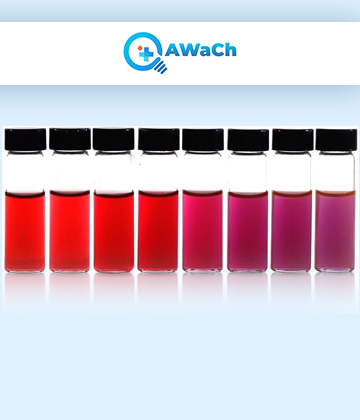Colloidal Gold
Colloidal gold refers to a suspension of gold nanoparticles in a liquid medium.
CD solutions contain gold nanoparticles that are exceptionally tiny, typically falling within the size range of 1 to 100 nanometers.
These nanoparticles showcase distinctive optical characteristics, such as a distinct red, pink, or purple hue, attributed to the interaction between light and particles at the nanoscale. As a result, colloidal gold or gold nanoparticles find application in binding with detection molecules to provide visual cues in numerous diagnostic tests, thereby boasting extensive utility in diagnostic healthcare. CD finds diverse applications across various fields.
What is Colloidal Gold ?
1. Biomedical Research: Colloidal Gold nano-particles are used in a wide range of biomedical applications, such as drug delivery systems, targeted therapy, and diagnostic assays. Their small size and surface properties allow for efficient cellular uptake and targeted delivery of therapeutic agents.
2. Diagnostic Testing:In diagnostic tests, cd frequently finds use, especially in lateral flow assays (like pregnancy tests and rapid diagnostic tests). Gold nanoparticles undergo functionalization with specific antibodies or antigens capable of attaching to target molecules within the test sample. This attachment interaction results in a noticeable alteration of color, Colloidal gold signifying the existence or nonexistence of the target molecule.
3. Imaging: Researchers utilize gold nanoparticles as contrast agents in imaging techniques like electron microscopy, optical imaging, and photoacoustic imaging. Their distinctive optical attributes facilitate improved visualization and monitoring of biological structures and processes.
4. Catalysis: Researchers employ colloidal gold nanoparticles as catalysts in multiple chemical reactions. Their extensive surface area and distinct catalytic characteristics render them proficient at driving particular reactions, including oxidation and reduction processes.
5. Nanotechnology:Nanotechnologists use colloidal gold as a foundational element, allowing them to construct intricate nanostructures and materials. By controlling the size, shape, and surface attributes of gold nanoparticles, researchers can design nanoscale devices with customized features suited to particular applications.

Colloidal gold, a captivating nanomaterial, consists of minuscule gold nanoparticles suspended in a liquid medium. Ranging from 1 to 100 nanometers, these particles display striking optical properties; often, they appear in shades of red, pink, or purple. These unique optical traits emerge from the interplay of light with these nanoscale elements. Moreover, in the realm of diagnostic healthcare, colloidal gold, or gold nanoparticles, have garnered extensive application. Their capacity to bind with detection molecules allows them to offer visual indicators in a wide array of diagnostic tests. Consequently, this capability has proven invaluable, revolutionizing diagnostic procedures and contributing significantly to advancements in the field of healthcare diagnostics.
Strength:
Colloidal gold's strength lies in its versatile applications. In biomedical research, it's crucial for drug delivery and diagnostics. Its tiny size and surface properties enable precise therapeutic delivery. Moreover diagnostics, it's vital for tests like pregnancy tests, causing visible color changes.
Advantages:
Certainly! I've revised the sentences to make them shorter while maintaining the information: Because boasts unique properties, essential in diverse scientific fields. Ing biomedical research, it enables precise drug delivery and targeted therapies. Into diagnostics, it simplifies result interpretation, providing rapid solutions. In imaging (e.g., electron microscopy), colloidal gold excels as a contrast agent, enhancing visualization. Its catalytic properties drive chemical reactions, advancing catalysis. In nanotechnology, it's a key building block for intricate structures, enabling customized nanoscale devices.
Recognitions:
Colloidalgold has gained recognition for its pivotal role in driving scientific innovation across various disciplines. Its impact spans from biomedical research to diagnostics, imaging, catalysis, and nanotechnology. The ability of colloidal gold nanoparticles to enhance the sensitivity of diagnostic assays, as exemplified by QAWaCh Bio's 'Q-probe,' underscores its, because significance in in vitro diagnostics and test development.
Innovation:
Innovations in the use of colloidal gold continue to expand its applications and improve its performance in various fields. Pioneering efforts, such as the development of 'Q-probe' by QAWaCh Bio, demonstrate the potential for colloidal gold to amplify the sensitivity of diagnostic assays, enabling more accurate and efficient testing methods. As advancements in nanomaterials and nanotechnology continue, colloidal gold remains a valuable tool at the forefront of scientific and medical research.
